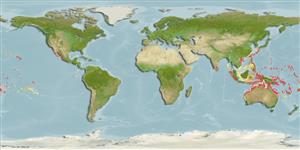Common names from other countries
>
Blenniiformes (Blennies) >
Blenniidae (Combtooth blennies) > Blenniinae
Etymology: Plagiotremus: Greek, plagios = oblique + Greek, trema = hole (Ref. 45335).
More on author: Whitley.
Environment: milieu / climate zone / depth range / distribution range
Écologie
marin récifal; profondeur 0 - 30 m (Ref. 90102). Tropical; 33°N - 32°S
Western Pacific: Philippines and Ryukyu Islands to the Gilbert Islands, New Caledonia, and Samoa, north to Izu Islands, south to Rowley Shoals and Lord Howe Island; throughout Micronesia. Subspecies Plagiotremus laudandus flavus occurs in Fiji and Tonga.
Taille / Poids / Âge
Maturity: Lm ? range ? - ? cm
Max length : 8.0 cm TL mâle / non sexé; (Ref. 9710)
Description synthétique
Clés d'identification | Morphologie | Morphométrie
Épines dorsales (Total) : 7 - 10; Rayons mous dorsaux (Total) : 27 - 30; Épines anales: 2; Rayons mous anaux: 22 - 24. Color variable, usually grey-blue and posterior part of the body often paler or yellow (Ref. 48636).
Adults are found solitary in coastal, lagoon and seaward reefs from below the surge zone to 30 m depth (Ref. 9710, 90102). They feed on skin, scales, fins and mucus of other fish. Oviparous. Eggs are demersal and adhesive (Ref. 205), and are attached to the substrate via a filamentous, adhesive pad or pedestal (Ref. 94114). Larvae are planktonic, often found in shallow, coastal waters (Ref. 94114). A mimic of Meiacanthus atrodorsalis (Ref. 2334). Minimum depth reported taken from Ref. 128797.
Life cycle and mating behavior
Maturities | Reproduction | Spawnings | Egg(s) | Fecundities | Larves
Oviparous, distinct pairing (Ref. 205).
Myers, R.F., 1991. Micronesian reef fishes. Second Ed. Coral Graphics, Barrigada, Guam. 298 p. (Ref. 1602)
Statut dans la liste rouge de l'IUCN (Ref. 130435)
Can't connect to MySQL database (fbapp). Errorcode: Too many connections
